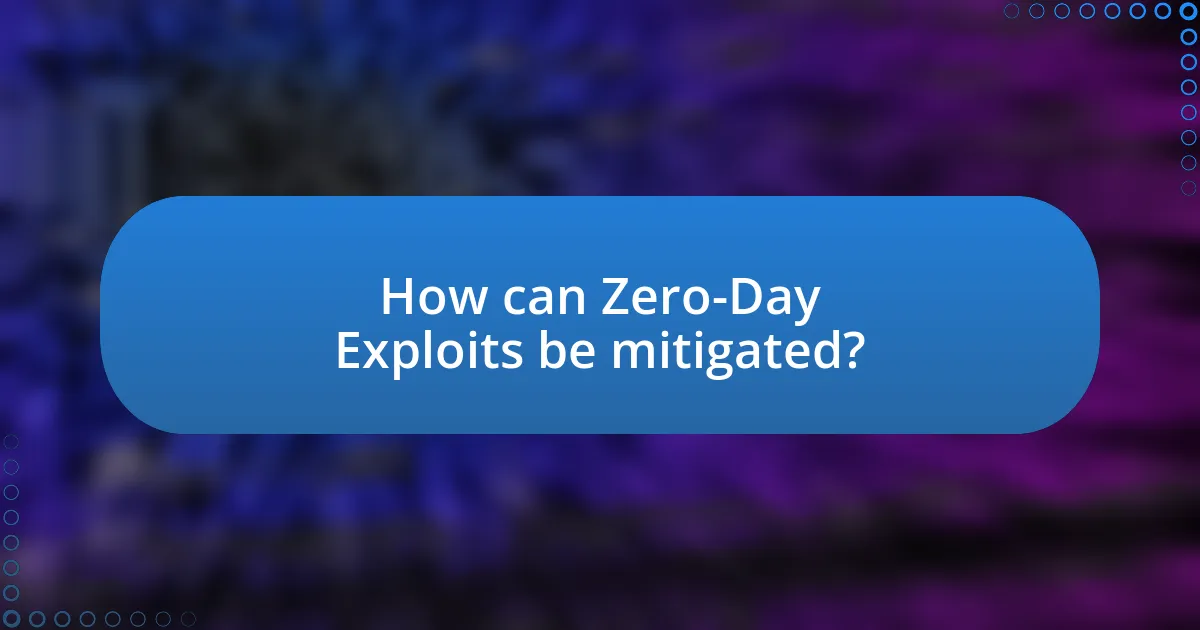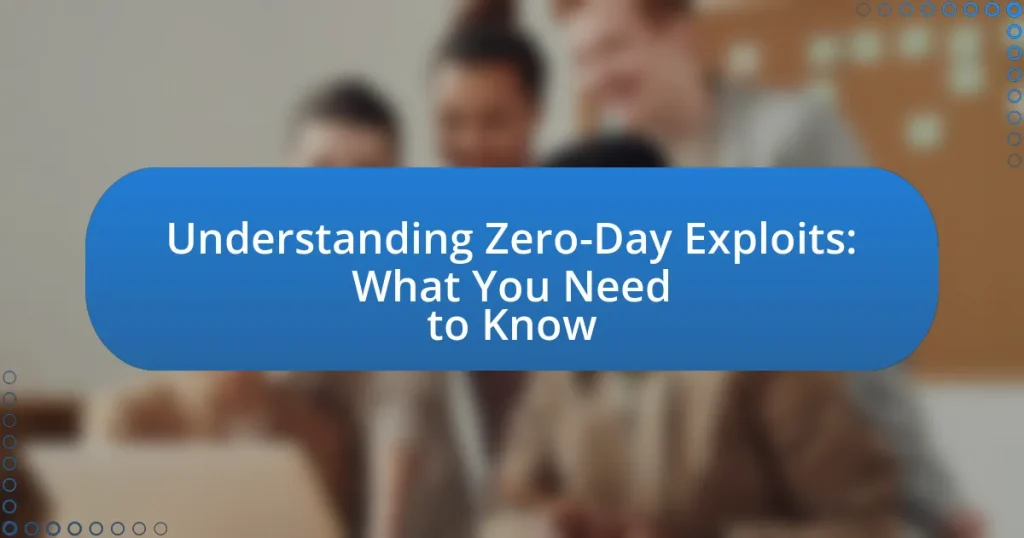Zero-day exploits are vulnerabilities in software or hardware that remain unknown to the vendor and unpatched, posing significant risks to cybersecurity. This article explores the nature of zero-day exploits, their differences from other vulnerabilities, and their potential impacts on organizations and individuals. It discusses how attackers discover and exploit these vulnerabilities, the consequences of successful attacks, and strategies for mitigation, including the importance of regular software updates and threat intelligence. Additionally, the article highlights emerging trends in zero-day exploits and the evolving tactics of cybercriminals, emphasizing the need for proactive security measures and collaboration to combat these threats effectively.

What are Zero-Day Exploits?
Zero-day exploits are vulnerabilities in software or hardware that are unknown to the vendor and have not yet been patched. These exploits are particularly dangerous because they can be used by attackers to compromise systems before the developers are aware of the issue and can issue a fix. According to a report by the cybersecurity firm Symantec, zero-day vulnerabilities can remain unpatched for an average of 30 days, allowing attackers ample time to exploit them.
How do Zero-Day Exploits differ from other types of vulnerabilities?
Zero-Day Exploits differ from other types of vulnerabilities in that they are unknown to the software vendor and have no available patch at the time of discovery. This lack of awareness allows attackers to exploit these vulnerabilities immediately, often leading to significant damage before a fix is implemented. In contrast, other vulnerabilities are typically known and may have patches or mitigations available, reducing the window of opportunity for exploitation. For instance, the 2017 Equifax breach involved a known vulnerability in Apache Struts, which had a patch available, yet the company failed to apply it, highlighting the difference in risk management between zero-day exploits and known vulnerabilities.
What defines a zero-day vulnerability?
A zero-day vulnerability is a security flaw in software that is unknown to the vendor and has not yet been patched. This type of vulnerability is particularly dangerous because it can be exploited by attackers before the software developer has a chance to address the issue, leaving users exposed to potential attacks. For instance, in 2020, a zero-day vulnerability in Microsoft Exchange Server was exploited by hackers, affecting thousands of organizations worldwide before a patch was released.
Why are zero-day exploits particularly dangerous?
Zero-day exploits are particularly dangerous because they take advantage of vulnerabilities in software that are unknown to the vendor and have no available patches. This lack of awareness allows attackers to exploit these vulnerabilities without any immediate defenses in place, leading to potential data breaches, system compromises, and widespread damage. For instance, the 2017 Equifax breach, which exposed sensitive information of 147 million people, was due to a zero-day vulnerability in Apache Struts that had not been patched. This demonstrates how zero-day exploits can have severe consequences, as they can be used to infiltrate systems before any protective measures are implemented.
What are the common characteristics of Zero-Day Exploits?
Zero-day exploits are characterized by their ability to target vulnerabilities that are unknown to the software vendor and have not yet been patched. These exploits are often highly effective because they can be used before any defensive measures are implemented. Additionally, zero-day exploits typically have a high market value in the cybercriminal community due to their rarity and potential for significant impact. According to a report by the Ponemon Institute, the average cost of a data breach involving a zero-day exploit can exceed millions of dollars, highlighting their severity and the urgency for organizations to enhance their security measures.
How do attackers typically discover zero-day vulnerabilities?
Attackers typically discover zero-day vulnerabilities through methods such as reverse engineering, fuzz testing, and analyzing software behavior. Reverse engineering involves deconstructing software to identify flaws in its code, while fuzz testing sends random data to applications to uncover unexpected behaviors that may indicate vulnerabilities. Additionally, attackers may monitor security updates and patches to find unaddressed weaknesses in software. Historical data shows that many zero-day vulnerabilities are found in widely used software, making them attractive targets for exploitation. For instance, the 2017 Equifax breach was attributed to a zero-day vulnerability in Apache Struts, highlighting the potential impact of such discoveries.
What methods do attackers use to exploit these vulnerabilities?
Attackers exploit vulnerabilities through various methods, including malware deployment, phishing attacks, and exploiting unpatched software. Malware can be used to gain unauthorized access to systems, while phishing attacks trick users into revealing sensitive information or downloading malicious software. Additionally, attackers often take advantage of unpatched software by using zero-day exploits, which target vulnerabilities that are not yet known to the software vendor, allowing them to execute arbitrary code or gain elevated privileges. These methods are effective because they leverage the element of surprise and the lack of defenses against unknown vulnerabilities.
What impact do Zero-Day Exploits have on cybersecurity?
Zero-day exploits significantly undermine cybersecurity by allowing attackers to exploit vulnerabilities before they are known or patched by software developers. These exploits can lead to unauthorized access, data breaches, and the deployment of malware, which can compromise sensitive information and disrupt operations. For instance, the 2017 Equifax breach, attributed to a zero-day vulnerability, exposed the personal data of approximately 147 million individuals, highlighting the severe consequences of such exploits on organizational security and consumer trust.
How do zero-day exploits affect organizations and individuals?
Zero-day exploits significantly impact organizations and individuals by exposing them to security vulnerabilities that can be exploited before a patch is available. These exploits can lead to unauthorized access to sensitive data, financial loss, and damage to reputation. For instance, the 2017 Equifax breach, which was attributed to a zero-day vulnerability, compromised the personal information of approximately 147 million individuals, resulting in an estimated cost of $4 billion for the company. Additionally, organizations may face legal repercussions and regulatory fines due to data breaches caused by such exploits. Individuals may experience identity theft and financial fraud as a direct consequence of their personal information being compromised.
What are the potential consequences of a successful zero-day attack?
A successful zero-day attack can lead to severe consequences, including data breaches, financial loss, and reputational damage. These attacks exploit previously unknown vulnerabilities in software, allowing attackers to gain unauthorized access to systems and sensitive information. For instance, the 2017 Equifax breach, which resulted from a zero-day vulnerability, exposed personal data of approximately 147 million individuals, leading to significant financial repercussions and loss of consumer trust. Additionally, organizations may face regulatory penalties and increased cybersecurity costs as they work to mitigate the damage and prevent future incidents.

How can Zero-Day Exploits be mitigated?
Zero-day exploits can be mitigated through a combination of proactive security measures, including regular software updates, the use of intrusion detection systems, and employee training on cybersecurity awareness. Regularly updating software and systems ensures that known vulnerabilities are patched, reducing the risk of exploitation. Intrusion detection systems can identify unusual behavior indicative of an exploit in action, allowing for timely responses. Additionally, training employees to recognize phishing attempts and other social engineering tactics can prevent initial access points for attackers. According to a report by the Ponemon Institute, organizations that implement comprehensive security training can reduce the risk of breaches by up to 70%.
What strategies can organizations implement to protect against zero-day exploits?
Organizations can implement several strategies to protect against zero-day exploits, including maintaining up-to-date software, employing intrusion detection systems, and utilizing threat intelligence. Keeping software updated minimizes vulnerabilities that attackers can exploit, as many zero-day attacks target unpatched systems. Intrusion detection systems can identify unusual behavior indicative of an exploit attempt, allowing for rapid response. Additionally, leveraging threat intelligence helps organizations stay informed about emerging threats and vulnerabilities, enabling proactive measures. According to a report by the Ponemon Institute, organizations that adopt a proactive security posture can reduce the risk of successful attacks significantly.
How important is regular software updating in prevention?
Regular software updating is crucial in preventing security vulnerabilities, including zero-day exploits. Software updates often include patches that fix known security flaws, thereby reducing the risk of exploitation by attackers. For instance, according to a report by the Cybersecurity & Infrastructure Security Agency (CISA), timely application of updates can mitigate up to 85% of vulnerabilities that are actively exploited in the wild. This demonstrates that consistent software maintenance is a fundamental practice for safeguarding systems against emerging threats.
What role does threat intelligence play in mitigation?
Threat intelligence plays a critical role in the mitigation of zero-day exploits by providing organizations with timely and relevant information about emerging threats. This intelligence enables proactive measures, such as patch management and vulnerability assessments, to be implemented before an exploit can be leveraged against systems. For instance, according to a report by the Ponemon Institute, organizations that utilize threat intelligence can reduce the average time to detect a breach by 50%, significantly lowering the risk associated with zero-day vulnerabilities.
What tools and technologies are available for detecting Zero-Day Exploits?
Tools and technologies available for detecting Zero-Day Exploits include Intrusion Detection Systems (IDS), Behavioral Analysis Tools, and Threat Intelligence Platforms. Intrusion Detection Systems monitor network traffic for suspicious activity and can identify anomalies that may indicate a Zero-Day exploit. Behavioral Analysis Tools utilize machine learning algorithms to establish a baseline of normal behavior and detect deviations that could signify an exploit. Threat Intelligence Platforms aggregate data from various sources to provide insights on emerging threats, including Zero-Day vulnerabilities. These tools are essential for proactive security measures, as they help organizations identify and mitigate risks associated with unknown vulnerabilities.
How do intrusion detection systems help in identifying zero-day attacks?
Intrusion detection systems (IDS) help in identifying zero-day attacks by monitoring network traffic and system behavior for anomalies that deviate from established baselines. These systems utilize signature-based detection, which identifies known threats, and anomaly-based detection, which flags unusual patterns that may indicate a zero-day exploit. For instance, according to a study published in the Journal of Cyber Security Technology, IDS can detect unusual outbound traffic or unexpected system calls that are characteristic of zero-day attacks, even when the specific exploit is unknown. This dual approach enhances the ability to recognize potential threats before they can cause significant damage.
What are the benefits of using automated vulnerability scanners?
Automated vulnerability scanners provide rapid identification of security weaknesses in systems, significantly enhancing an organization’s security posture. These tools can scan large networks and applications quickly, detecting vulnerabilities that may be overlooked during manual assessments. According to a study by the Ponemon Institute, organizations using automated scanning tools can reduce the time to identify vulnerabilities by up to 80%, allowing for faster remediation and minimizing the window of exposure to potential zero-day exploits. Additionally, automated scanners offer consistent and repeatable assessments, ensuring that security checks are performed regularly and comprehensively, which is crucial for maintaining compliance with industry standards and regulations.

What are the latest trends in Zero-Day Exploits?
The latest trends in zero-day exploits include an increase in the targeting of cloud services and remote work applications, as attackers exploit vulnerabilities in widely used software. Recent reports indicate that the average time to discover a zero-day exploit has decreased, with some vulnerabilities being exploited within days of their discovery. Additionally, there is a growing trend of using artificial intelligence to automate the discovery and exploitation of these vulnerabilities, making it easier for attackers to launch sophisticated attacks. According to a 2023 report by the cybersecurity firm Mandiant, the number of zero-day vulnerabilities reported has risen by 30% compared to the previous year, highlighting the escalating threat landscape.
How has the landscape of zero-day exploits evolved in recent years?
The landscape of zero-day exploits has evolved significantly in recent years, characterized by an increase in both frequency and sophistication. Research indicates that the number of reported zero-day vulnerabilities has risen, with 2021 witnessing a record high of 66 zero-day exploits, according to the Google Project Zero team. Additionally, attackers have become more adept at leveraging these vulnerabilities, often using advanced techniques such as automated tools and exploit kits to maximize their impact. This evolution is further evidenced by the growing trend of zero-day exploits being sold on underground markets, highlighting a shift towards a more commercialized approach to cybercrime.
What emerging technologies are influencing zero-day exploit tactics?
Emerging technologies such as artificial intelligence, machine learning, and the Internet of Things (IoT) are significantly influencing zero-day exploit tactics. These technologies enhance the capabilities of attackers by automating the discovery of vulnerabilities and enabling more sophisticated attack methods. For instance, AI-driven tools can analyze vast amounts of code to identify potential weaknesses faster than traditional methods, leading to the rapid development of zero-day exploits. Additionally, the proliferation of IoT devices increases the attack surface, providing more opportunities for exploitation. According to a report by Cybersecurity Ventures, the number of connected IoT devices is expected to reach 75 billion by 2025, further complicating security measures and increasing the likelihood of zero-day vulnerabilities being exploited.
How are cybercriminals adapting to new security measures?
Cybercriminals are adapting to new security measures by employing advanced techniques such as automation, machine learning, and social engineering. These adaptations allow them to bypass traditional defenses and exploit vulnerabilities more effectively. For instance, the use of automated tools enables cybercriminals to scan for zero-day vulnerabilities rapidly, which are security flaws not yet known to the software vendor. According to a report by the Ponemon Institute, 60% of organizations experienced a zero-day attack in the past year, highlighting the increasing sophistication of cybercriminal tactics in response to evolving security protocols.
What are the implications of zero-day exploits for future cybersecurity?
Zero-day exploits significantly threaten future cybersecurity by exposing vulnerabilities before they are patched, leading to increased risks of data breaches and system compromises. As organizations increasingly rely on digital infrastructure, the prevalence of zero-day vulnerabilities can undermine trust in software and hardware systems. For instance, the 2020 SolarWinds attack, which exploited a zero-day vulnerability, affected thousands of organizations, including U.S. government agencies, highlighting the potential for widespread damage. Consequently, the implications include a heightened need for proactive security measures, such as continuous monitoring and rapid incident response, to mitigate the risks associated with these exploits.
How can organizations prepare for the future of zero-day threats?
Organizations can prepare for the future of zero-day threats by implementing a multi-layered security strategy that includes continuous monitoring, threat intelligence, and regular software updates. Continuous monitoring allows organizations to detect unusual activities that may indicate a zero-day exploit in progress. Threat intelligence provides insights into emerging vulnerabilities and attack vectors, enabling proactive defenses. Regular software updates and patch management are critical, as they address known vulnerabilities that could be exploited in conjunction with zero-day threats. According to a report by the Ponemon Institute, organizations that adopt a proactive approach to vulnerability management can reduce the risk of successful attacks by up to 50%.
What role does collaboration play in combating zero-day exploits?
Collaboration is essential in combating zero-day exploits as it enables the sharing of threat intelligence, resources, and expertise among cybersecurity professionals and organizations. By working together, entities can quickly identify vulnerabilities, develop patches, and disseminate information about emerging threats. For instance, initiatives like the Cyber Threat Alliance facilitate real-time sharing of data regarding zero-day vulnerabilities, which enhances collective defense mechanisms. This collaborative approach has been shown to reduce the time to respond to such exploits, as evidenced by the rapid deployment of patches following coordinated efforts among tech companies and security researchers.
What best practices should individuals and organizations follow regarding Zero-Day Exploits?
Individuals and organizations should implement a multi-layered security approach to effectively mitigate the risks associated with Zero-Day Exploits. This includes maintaining up-to-date software and systems, as 60% of breaches occur due to unpatched vulnerabilities, according to the Verizon Data Breach Investigations Report. Regularly applying security patches and updates helps close potential gaps that attackers could exploit.
Additionally, employing intrusion detection systems (IDS) can help identify unusual activities indicative of an exploit in action. Organizations should also conduct regular security training for employees, as human error is a significant factor in successful attacks. The 2021 Cybersecurity Workforce Study by (ISC)² found that 95% of cybersecurity breaches are due to human error, highlighting the importance of awareness and training.
Furthermore, utilizing threat intelligence services can provide timely information about emerging threats, allowing proactive measures to be taken. Establishing an incident response plan ensures that both individuals and organizations can respond swiftly to any potential exploit, minimizing damage.
How can users stay informed about potential zero-day vulnerabilities?
Users can stay informed about potential zero-day vulnerabilities by subscribing to cybersecurity news feeds, following reputable security blogs, and monitoring threat intelligence platforms. Cybersecurity news outlets like Krebs on Security and Threatpost regularly report on emerging vulnerabilities, while platforms such as the National Vulnerability Database provide updates on known vulnerabilities. Additionally, organizations like the Cybersecurity and Infrastructure Security Agency (CISA) issue alerts and advisories regarding zero-day threats, making them a reliable source for timely information.
What steps should be taken immediately after a zero-day exploit is discovered?
Immediately after a zero-day exploit is discovered, organizations should isolate affected systems to prevent further damage. This step is crucial as it limits the exploit’s ability to spread and protects sensitive data. Following isolation, the next actions include assessing the extent of the breach, gathering forensic evidence, and notifying relevant stakeholders, including cybersecurity teams and affected users. Additionally, organizations should begin developing and deploying patches or workarounds to mitigate the vulnerability. This approach is supported by the fact that timely response can significantly reduce the impact of such exploits, as demonstrated in incidents like the 2017 Equifax breach, where delayed action led to extensive data loss.


